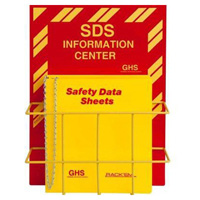| The Home page of ILPI's Safety Data Sheet (SDS) Resource, the leader in SDS information since 1995! | |
| The history and philosophy behind this resource. | |
| A curated collection of books and reference materials concerning Safety Data Sheets and closely related topics. | |
| Paste your plain text SDS into the SDS-Demystifier, and it will be converted into a hypertext-enriched document with links to detailed explanations of each key term. | |
| An extensive list of frequently asked questions about Safety Data Sheets including regulations, content, compliance, and more. | |
| A humorous take on Safety Data Sheet jargon. Fill in the blanks on our entry form to generate a personalized Unsafety Data Sheet to share with your coworkers. | |
| Since 1995, we've maintained this massive curated list of the best places to find Safety Data Sheets on the Internet. | |
| Way more than a glossary, this hypertext-enhanced resource covers hundreds of SDS-related terms and expert knowledge. Each entry includes both the SDS relevance and links to additional authoritative resources. | |
| Archived results of Safety Data Sheet related polls taken by some of our millions of site visitors | |
| You are here! The OSHA regulations behind SDS regulations, including the inspection guidelines and over 400 official interpretations letters under the Hazard Communication Standard | |
| Commercial suppliers of SDS authoring and management software as well as cloud compliance services. | |
| Commercial companies that will create SDS's for your specific needs as well as SDS translation companies. |

Safety signs, banners, and scoreboards? Get yours at Safety Emporium!
| Title: 12/29/1992 - OSHA's Hazard Communication Standard. | |
| Record Type: Interpretation | Standard Number: 1910.1200 |
December 29, 1992
Mr. Stephen Hill
Vice President
Britthaven, Inc.
Post Office Box 6159
1214 Highway 258 N
Kinston, North Carolina 28502-6159
Dear Mr. Hill:
This is in further response to your inquiry of September 25, concerning the Occupational Safety and Health Administration's (OSHA) Hazard Communication Standard, 29 CFR 1910.1200.

Your employees can stay informed and safety-ready with right to know stations and labels from Safety Emporium.
Sara Prueitt of my staff contacted you to see if she could answer your questions over the telephone, however you requested written clarification for your files. You asked whether your long term health care facilities would fall under the scope of the Hazard Communication standard (HCS) in cases where your residents buy their medications from pharmacies that are independent from your facilities and which are prescribed to them by outside physicians.
The HCS applies to your staff of health professionals in many ways, as you have acknowledged. For example, Britthaven would have to inform employees of the hazards involved in using standard (i.e. foreseeable) medications used in practicing health care in your facility, such as the "house drugs" mentioned in your telephone conversation. However, in cases where the residents of your facilities purchase drugs from independent/outside pharmacies, and the drug and its potential hazards are not known until an outside physician orders a prescription, the HCS would not apply.
The purpose of HCS is to communicate information concerning hazards and appropriate protective measures to employees. Employers must provide information to their employees about the hazardous chemicals to which they are exposed by means of a written hazard communication program. The hazard communication program must be developed, implemented and maintained at the workplace, and must also include a list of hazardous chemicals known to be present at the worksite.
Employees must be allowed to have access to information; therefore, if employees find themselves working with a medication brought in by a resident they may ask their employer to obtain a material safety data sheet for the medication. The HCS requires employers to provide information on "any chemical which is known to be in the workplace in such a manner that employees may be exposed..." (29 1910.1200(a). Britthaven's facilities must incorporate their individual method of compliance into its existing HCS program.

We have all kinds of safety wall signs at Safety Emporium.
Please find enclosed a copy of the OSHA booklet "Chemical Hazard Communication" which explains the standard and employers' responsibility under the rule. Under the Occupational Safety and Health Act of 1970, States are permitted to assume responsibility for their own occupational safety and health programs under a plan approved and closely monitored by Federal OSHA. The North Carolina Department of Labor operates under such a plan. As a condition of plan approval, States are required to adopt and enforce standards that are either identical to or "at least as effective" as the Federal standards. For information regarding the requirements of North Carolina standards, you may want to contact:
North Carolina Department of Labor
4 West Edenton Street
Raleigh, North Carolina 27601
Telephone: (919) 733-7166
We hope this information is helpful. If you have any further questions please contact the Office of Health Compliance Assistance at (202) 219-8036.
Sincerely,
Roger A. Clark, Director
Directorate of Compliance Programs
The original official public domain version of this document is available from OSHA at https://www.osha.gov/laws-regs/standardinterpretations/1992-12-29.